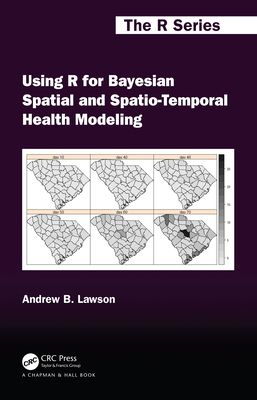Applied Spatial Statistics for Public Health Data (Hardcover)
暫譯: 公共衛生數據的應用空間統計學 (精裝版)
Lance A. Waller, Carol A. Gotway
- 出版商: Wiley
- 出版日期: 2004-07-15
- 售價: $5,810
- 貴賓價: 9.5 折 $5,520
- 語言: 英文
- 頁數: 520
- 裝訂: Hardcover
- ISBN: 0471387711
- ISBN-13: 9780471387718
-
相關分類:
機率統計學 Probability-and-statistics
已絕版
買這商品的人也買了...
-
 精通 Visual Basic.NET 中文版黑皮書 (Visual Basic.NET Black Book)
精通 Visual Basic.NET 中文版黑皮書 (Visual Basic.NET Black Book)$750$585 -
 程式設計專家手冊 (The Practice of Programming)
程式設計專家手冊 (The Practice of Programming)$420$332 -
 CCNA Self-Study: Interconnecting Cisco Network Devices (ICND) 640-811, 640-801, 2/e
CCNA Self-Study: Interconnecting Cisco Network Devices (ICND) 640-811, 640-801, 2/e$2,120$2,014 -
 Windows CE 嵌入式系統理論與實務
Windows CE 嵌入式系統理論與實務$680$537 -
 ASP.NET 徹底研究進階技巧─高階技巧與控制項實作
ASP.NET 徹底研究進階技巧─高階技巧與控制項實作$650$507 -
 最新詳解 Javascript & HTML & CSS 語法辭典(增訂新版)
最新詳解 Javascript & HTML & CSS 語法辭典(增訂新版)$490$382 -
 計算機概論 (Computer Science: an Overview, 8/e)
計算機概論 (Computer Science: an Overview, 8/e)$550$523 -
 InDesign CS2 蝴蝶效 IN
InDesign CS2 蝴蝶效 IN$720$612 -
 軟體預先架構之美學 (Prefactoring)
軟體預先架構之美學 (Prefactoring)$580$458 -
 如何設計好網站 (Don't Make Me Think: A Common Sense Approach to Web Usability, 2/e)
如何設計好網站 (Don't Make Me Think: A Common Sense Approach to Web Usability, 2/e)$450$383 -
 Java Puzzler 中文版─陷阱、錯誤 (Java Puzzlers: Traps, Pitfalls, and Corner Cases)
Java Puzzler 中文版─陷阱、錯誤 (Java Puzzlers: Traps, Pitfalls, and Corner Cases)$520$442 -
 Microsoft SQL Server 2005 設計實務
Microsoft SQL Server 2005 設計實務$680$578 -
 ASP.NET 2.0 程式設計
ASP.NET 2.0 程式設計$650$553 -
 Fedora Core 5 Linux 安裝與系統管理
Fedora Core 5 Linux 安裝與系統管理$580$458 -
 專案管理之美學 (The Art of Project Management)
專案管理之美學 (The Art of Project Management)$620$490 -
 Ajax 網頁程式設計─Google 成功背後的技術
Ajax 網頁程式設計─Google 成功背後的技術$580$493 -
 Ajax 與 Google Map API 入門實作
Ajax 與 Google Map API 入門實作$450$351 -
 最新 JavaScript 與 Ajax 範例活用辭典
最新 JavaScript 與 Ajax 範例活用辭典$390$304 -
 ASP.NET 2.0 深度剖析範例集
ASP.NET 2.0 深度剖析範例集$650$507 -
 Microsoft SQL Server 2005 管理實務
Microsoft SQL Server 2005 管理實務$680$578 -
 操作介面設計模式 (Designing Interfaces)
操作介面設計模式 (Designing Interfaces)$880$695 -
 Ajax 實戰手冊 (Ajax in Action)
Ajax 實戰手冊 (Ajax in Action)$680$537 -
 Ajax 技術手冊 (Foundations of Ajax)
Ajax 技術手冊 (Foundations of Ajax)$450$356 -
 世紀末軟體革命復刻版:C++、GUI 與物件導向理論
世紀末軟體革命復刻版:C++、GUI 與物件導向理論$620$527 -
 聖殿祭司的 ASP.NET 2.0 專家技術手冊─使用 C#
聖殿祭司的 ASP.NET 2.0 專家技術手冊─使用 C#$720$569
相關主題
商品描述
An application-based introduction to the statistical analysis of spatially referenced health data
Sparked by the growing interest in statistical methods for the analysis of spatially referenced data in the field of public health, Applied Spatial Statistics for Public Health Data fills the need for an introductory, application-oriented text on this timely subject. Written for practicing public health researchers as well as graduate students in related fields, the text provides a thorough introduction to basic concepts and methods in applied spatial statistics as well as a detailed treatment of some of the more recent methods in spatial statistics useful for public health studies that have not been previously covered elsewhere.
Assuming minimal knowledge of spatial statistics, the authors provide important statistical approaches for assessing such questions as:
- Are newly occurring cases of a disease "clustered" in space?
- Do the cases cluster around suspected sources of increased risk, such as toxic waste sites or other environmental hazards?
- How do we take monitored pollution concentrations measured at specific locations and interpolate them to locations where no measurements were taken?
- How do we quantify associations between local disease rates and local exposures?
- After reviewing traditional statistical methods used in public health research, the text provides an overview of the basic features of spatial data, illustrates various geographic mapping and visualization tools, and describes the sources of publicly available spatial data that might be useful in public health applications.
Table of Contents
Preface.
Acknowledgments.
1. Introduction.
2. Analyzing Public Health Data.
3. Spatial Data.
4. Visualizing Spatial Data.
5. Analysis of Spatial Point Patterns.
6. Spatial Clusters of Health Events: Point Data for Cases and Controls.
7. Spatial Clustering of Health Events: Regional Count Data.
8. Spatial Exposure Data.
9. Linking Spatial Exposure Data to Health Events.
References.
Author Index.
Subject Index.
商品描述(中文翻譯)
**描述**
這本書是針對空間參考健康數據的統計分析進行應用導向的介紹。
隨著公共衛生領域對於空間參考數據分析的統計方法日益增長的興趣,《公共衛生數據的應用空間統計》滿足了對於這一及時主題的入門應用文本的需求。本書為公共衛生研究人員及相關領域的研究生撰寫,提供了應用空間統計的基本概念和方法的全面介紹,以及對一些在公共衛生研究中有用的較新空間統計方法的詳細探討,這些方法在其他地方尚未被涵蓋。
本書假設讀者對空間統計的知識有限,作者提供了評估以下問題的重要統計方法:
- 新發病病例是否在空間上「聚集」?
- 這些病例是否圍繞著懷疑的風險來源聚集,例如有毒廢物場或其他環境危害?
- 我們如何將在特定位置測量的污染濃度進行插值,以推估未測量位置的數據?
- 我們如何量化當地疾病率與當地暴露之間的關聯?
- 在回顧公共衛生研究中使用的傳統統計方法後,本書提供了空間數據的基本特徵概述,展示了各種地理映射和可視化工具,並描述了可能在公共衛生應用中有用的公開可用空間數據來源。
**目錄**
前言
致謝
1. 介紹
2. 分析公共衛生數據
3. 空間數據
4. 可視化空間數據
5. 空間點模式分析
6. 健康事件的空間聚集:病例與對照的點數據
7. 健康事件的空間聚集:區域計數數據
8. 空間暴露數據
9. 將空間暴露數據與健康事件聯繫起來
參考文獻
作者索引
主題索引
















